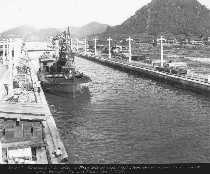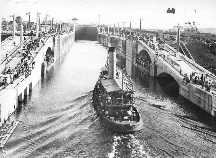The first vessels to transit the Panama Canal
 In 1913 the works in the Panama Canal were continuing
with incredible speed and ahead of the previously established schedule.
In 1913 the works in the Panama Canal were continuing
with incredible speed and ahead of the previously established schedule.
The monumental work and hereto unmatched engineering feat struck wonderment in the many visitors who came on tours from the United States and other parts of the world.
The trips to Gatun Lake began on Sunday, February 8, 1914, on barges at a cost of $1.50 each passenger, and lasted two hours and twenty minutes.
The operational mechanism to open and close the locks was the product of Edward Schildhauer’s ingenuity. He was also the designer of the locomotives that pull the vessels prior to their entering the locks, because regulations prohibited the vessels from operating their engines.
On June 11, 1913, two huge steam shovels met on the bottom of Gaillard Cut, as they finished breaking up the northern and southern ranges, opening the way to two-way traffic. The big ditch had been dug.
On September 26, 1913, Gatun locks were tested for the first time with a barge named GATUN, which transited to the lake of the same name. The success of this trial run further increased the high morale and pride of the Canal workforce.
On October 10, from Washington, President Woodrow Wilson with the push of a button detonated the dam that separated the waters in Gaillard Cut and Gatun Lake, thus establishing the great waterway and ending four centuries of heroic efforts that had cost many lives.
Continuing the preparatory phase, on October 24, 1913, a convoy of barges, dredges, excavators, and other types of working vessels crossed the Miraflores and Pedro Miguel Locks to become the first to use the system on the Pacific side.
The works progressed up to December 10, 1913, when an old vessel—a holdover from the French period called MARMOT—sailed the entire Gaillard Cut.
On January 7, 1914, another veteran vessel of the French era, the ALEXANDRE LAVALLEY, crossed the canal from end to end, unceremoniously.
Everything had been perfect and the enthusiasm of the workers was beyond words as it inched its way through the locks.
At the end, the works were being carried out swiftly and the reductions in the workforce were being made expeditiously.
On May 18, 1914, the Canal was given commercial use when three barges loaded with sugar and aided by tugs MARINER, LA BOCA, AND PORTOBELLO, sailed from Balboa to Cristobal and returned on the following day.
On the 25th of May, the launch LOUISE sailed through the Gaillard Cut and on June 8 the ALLIANCA of the Panama Railroad Steamship Company left Cristobal for Gatun Lake and returned on the same day.
The first ocean-to-ocean vessel was the CRISTOBAL, property of the Panama Railroad Steamship Line, which sailed from the port of the same name in the Atlantic on August 3 at 7 a.m., arriving at Balboa in the Pacific at 6:30 p.m.
On the following day, it embarked on its return trip at 7:30 a.m. and arrived at Cristobal at 4 p.m. in a clear demonstration of the efficiency and safety of the Panama Canal. It carried as invited passengers previously selected long-time Canal workers and their families, in recognition of their performance and dedication to duty.
On Sunday, August 9, the ADVANCE left Cristobal and went through the Miraflores locks, returning immediately to Gatun and got underway on the following day.
Steamship PANAMA, which arrived from New York, made a similar transit through the Canal, carrying another group of workers as guest passengers.
After a detailed preparation, the inaugural voyage through the Canal was scheduled for August 15, 1914, by the Steamship ANCON, property of the Panama Railroad Steamship Line, under the leadership of Commander G. E. Sulkforth. The vessel was a veteran of many battles, inasmuch as its main endeavor was to transport passengers and carry cement. It was the sister ship of the CRISTOBAL.
Invitations were issued to more than 200 personalities, headed by the President of the Republic, Dr. Belisario Porras, his wife, the Cabinet, the Diplomatic and Consular Corps, Canal Zone officials and high-ranking military officers, all of whom were given a special pass signed by Governor George W. Goethals.
A special distinction was awarded the following Panamanian citizens by inviting them on the voyage; these were, Samuel Lewis A., Carlos M. Mendoza, Dr. Augusto Samuel Boyd, Dr. Juan Demóstenes Arosemena, Dr. Pablo Arosemena, Ricardo Arias, and Dr. Manuel J. Rodríguez.
Special instructions had been included on how to get to the vessel at Cristobal Pier No. 9 at 7 a.m. The Railroad Company trains carried all guests from Panama and Emperador. The fixed departure time was 5 a.m.
The Swiss-Italian colony in San Francisco, California, sent a gift of champagne to be served throughout the inaugural voyage of the Canal. The duration of this voyage was 9 hours, 40 minutes.
All present were also given a commemorative medal of the opening of the Panama Canal to worldwide commerce, which bore the following inscription: This registered medal, is numbered by series and is one of 50,000 carried aboard the vessel that made the maiden voyage through the Panama Canal, and is authenticated by a certificate signed by George W. Goethals, Chief Engineer and President of the Isthmian Canal Commission."
However, Goethals himself did not go on the inaugural voyage, inasmuch as he was overseeing the operation of the locks and ensuring that all details were going smoothly as, in fact, was the case.
 A large crowd lined up along the locks and adjacent
areas of the Port of Balboa to witness the great event of the century.
A large crowd lined up along the locks and adjacent
areas of the Port of Balboa to witness the great event of the century.
The opening of the Panama Canal to world maritime trade was not given its due prominence in the news of the day. Instead, it was relegated to page 3 of the dailies, overshadowed by the recent outbreak of World War I (August 3, 1914), which had begun to devastate the fields of Europe.
On Sunday, August 16, commercial steamships began transiting the waterway. These ships had been in the Bay of Panama awaiting the completion of the Canal inaugural ceremonies.
On August 17 and 18, the PLEIADES, the PENNSYLVANIAN, and the ARIZONIAN took the route to Cristobal, while the MISSOURIAN, NEBRASKAN, and yachts LASATA, ISABELLE, and ALMIRANTE DEWEY traveled to Balboa.
The following day the SANTA CATALINA, KENTUCKIAN, and MONTANAN were on their way to Cristobal.
The first war ship to cross the interoceanic waterway was the torpedo boat TENIENTE RODRIGUEZ of the Peruvian navy. This transit was made on August 18 from Cristobal to Balboa.
Traffic through the Panama Canal was very slow during the first months. The average was 4 to 5 vessels a day (it bears remembering that only daylight transits were made, inasmuch as lighting for nighttime transit was not installed until 1966).
After the first few transits through the Panama Canal, things settled into the same routine of the initial successes, and an unending parade of vessels through the waterway. This has continued uninterrupted for over 80 years now, as a sincere tribute to all those who lost their lives in this colossal enterprise and for those privileged few who were able to see it through to completion.